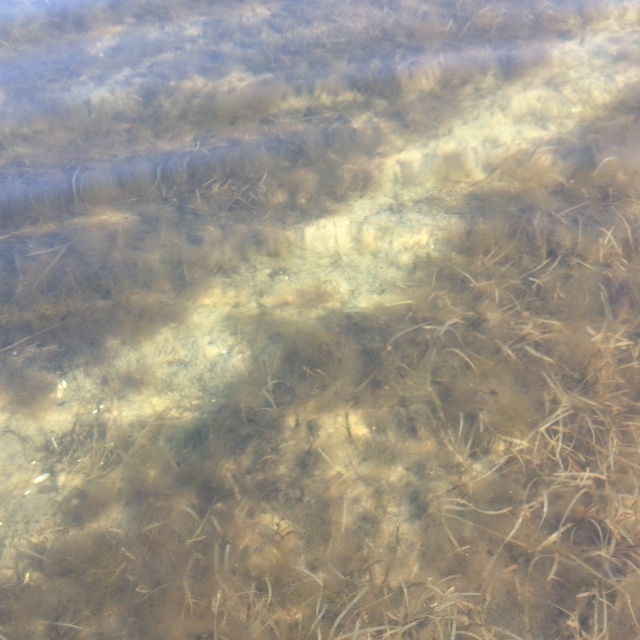
by Chris Verlinde | Feb 28, 2020
What’s the big deal about seagrasses?
Seagrass meadows are made up of plants that live under water in our local estuaries. Just like the grass and plants in our yards where many types of insects, worms and small animals live, seagrass meadows provide habitat for many types of young fish and invertebrates, such as crabs and shrimp.

Between 70 and 90% of fish, crabs and shrimp that recreational and commercial fishermen catch, spend some time during their life in seagrass beds. In 2014, the commercial fishing industry contributed nearly $140 million, while recreational fishing spending contributed $6 billion to Florida’s Economy. If we did not have healthy seagrasses, we would not have this economic impact on our coastal economies (http://gulffishinfo.org/Gulf-Fisheries-Economics).
In addition:
· As seagrass blades move with the currents and tides, sediments are removed from the water, which contributes to improved water clarity.
· Seagrasses are the same type of plants that grow on land, they produce oxygen for marine life.
· Seagrasses filter excess nutrients from the water.
· Provide food and shelter for juvenile fish, shrimp and crabs.
· Endangered species such as manatees and green sea turtles depend on seagrass beds for food.
· Migratory birds depend on seagrass beds for foraging needs.
What can you do to help protect seagrasses?
While boating:
• Avoid seagrass beds. If you do run aground in a seagrass bed, turn off your engine, tilt up the engine and walk or pole your boat out of the shallow water.
• Be safe and know water depths and locations of seagrass beds by studying navigational charts.
• Seagrasses are usually found in shallow water and appear as dark spots or patches. Wear polarized sunglasses (to reduce glare) to help locate these areas.
• Always choose to use a pump-out station for your marine sanitation device.
• Stay in marked channels.
At home:
• To reduce pollution from entering our waterways, keep a buffer of native plants along your shoreline. This will also help to protect your property from erosion and slow flood waters during storm events.
• To save money, plant native plants that don’t require a lot of fertilizers and pesticides. Avoid seagrass beds when planning for dredging activities or pier construction.
• Comply with Shoreline Protection construction codes
• Maintain septic tanks.
In your community:
• Families and children can get out and snorkel these areas! Many sites are easy to access from public parks.
• Get involved with local organizations that promote nature protection.
• Working together, we can share with community members what we have learned about seagrasses at the 20th annual Seagrass Awareness Celebration, March 6, 2020 from noon until 4 pm at Shoreline Park South in Gulf Breeze Fl.
• Don’t litter!
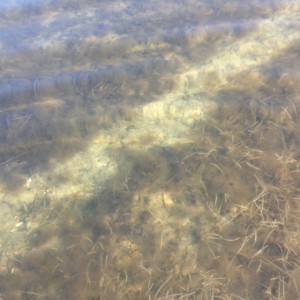
The scarring of seagrass but a propeller.
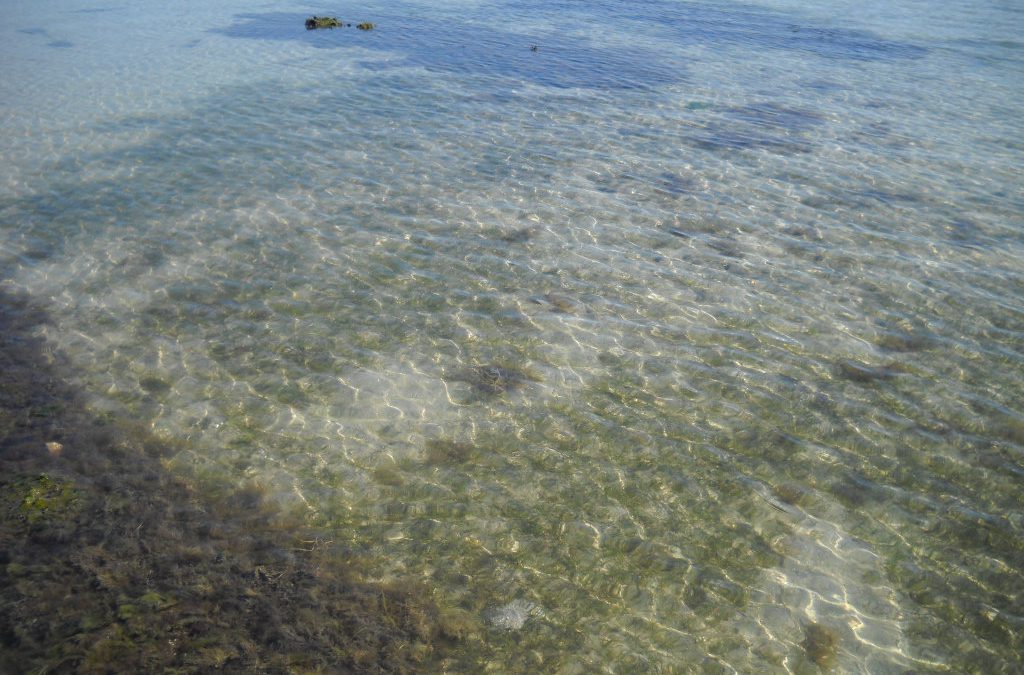
by Rick O'Connor | Dec 19, 2018
Most everyone knows the importance of submerged seagrass in our coastal estuaries. It has been estimated that 80% of the commercial and recreational important marine species depend on seagrasses for at least part of their life cycle. One acre of submerged seagrass can produce 10 tons of leaves, support 40,000 fish, and 50 million invertebrate species. Not everyone in the panhandle lives on the coast, but many who live inland enjoy fishing there, so the concern for the health of our grassbeds does extend inland.
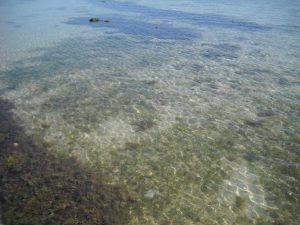
Shoal grass. One of the common seagrasses in Florida.
Photo: Leroy Creswell
In the Pensacola Bay area, the decline of seagrass was first reported in the 1950s. A 95% decline occurred between 1950 and 1980. The decline in local bay scallop and shrimp over the years has been attributed to the decline of these grassbeds. Aerial surveys have shown steady decreases in acres until 2003. From 2003 until 2010, there was an 8.4% increase in seagrass acreage in the Pensacola Bay System. All bodies of water showed increases except Santa Rosa Sound and Big Lagoon, which had slight losses in seagrass coverage. The most recent reports from an FWC study (2010-2015), suggest the seagrasses in the Big Lagoon and Santa Rosa Sound area have increased 13%.
Despite these recent gains, and anecdotal reports of “healthy seagrass”, many of the historic beds have not recovered. Historically, seagrass restoration efforts have not been very successful. Natural restoration seems to be the best target at the moment. To do this, you will need to reduce the stressors that caused the declines in the first place. Some of the possible stressors include: dredging, trawling, decreased water clarity, prop scarring, dock shading, and armored shorelines – to name a few.
To this end, a citizen science project was developed by a partnership with the University of West Florida and the Florida Sea Grant Extension Programs in Santa Rosa and Escambia counties. Volunteers who live on, or near, these bodies of water were trained to monitor the seagrass beds near their homes. Eleven 1-nautical mile square grids were set up in Big Lagoon and 55 were marked for Santa Rosa Sound. Volunteers selected beaches within one of these grids to survey. In 2018, five of the Big Lagoon and six of the Santa Rosa Sound grids were monitored. Within their grids, volunteers selected four locations to monitor once a month between May and October. Using snorkels, volunteers placed a 0.25m2 PVC square (quadrat) on the bottom over the grass. The percent coverage was estimated and species of grass within identified and recorded. Volunteers recorded whether drift algae was present on the grasses (these could be a problem for them) and a list of any marine animals they may have found. They also collected a water sample to be analyzed for total suspended solids and nutrients by students at the University of West Florida. UWF students also visited sites during the year to collect data on salinity, temperature, dissolved oxygen, nitrites, nitrates, ammonia, total phosphorus, and pH.
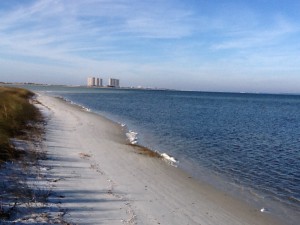
The darker areas in the water are seagrasses. Photo: Rick O’Connor
So how did the first year go?
Pretty good!
The average percent coverage of seagrass for all locations was between 60-70%, some locations in Santa Rosa Sound were 100% coverage for their stations. The percent coverage of the epiphytic drift algae was between 2-8%. There was no real difference between Santa Rosa Sound and Big Lagoon in seagrass coverage however there was for the epiphytic drift algae – Big Lagoon had more. The UWF environmental data also found a higher concentration of chlorophyll a in Big Lagoon. This suggest either more runoff into Big Lagoon, or the runoff has more nutrients in it. Overall nutrients were relatively low. There was a decrease in salinity as the rain increased. The more common species of seagrass are not fans of low salinity, but Widgeon grass (Ruppia maritima) is – and we did see increases in this species as we moved into September, again – probably due to lower salinities.
We will continue to monitor these grassbeds for several years and really hope we see signs of natural restoration.
REFERENCES
Caffrey, J. 2018. Unpublished report on seagrass monitoring.
Lewis, M. J.T. Kirschenfeld, T. Goodheart. 2016. Environmental Quality of the Pensacola Bay System: Retrospective Review for Future Resource Management and Rehabilitation. U.S. Environmental Protection Agency, Gulf Breeze FL. EPA/600/R-16/169.

by Rick O'Connor | Apr 14, 2018

Shoal grass. One of the common seagrasses in Florida.
Photo: Leroy Creswell
For many, it really does not matter. But is there a difference? Yes… there is. Seagrass is what typically washes ashore on the Sound side – seaweed is what we typically see on the Gulf.
So what is the difference?
Seagrasses are actually grasses. They are true plants in the sense they have roots, stems, and leaves. They also produce flowers, but they are so small it is very hard to see them. Pollen and seed dispersal is via the currents. What the observer sees when snorkeling in seagrass meadows are the leaves – in this case called blades. The stems run horizontal beneath the sand, as many grasses in our lawns do. These are called rhizomes, and the roots extend from them. Turtle grass and Shoal grass are the two most common types we have here.
Seaweeds on the other hand, are not true plants because they lack roots, stems, and leaves. They are often called algae and must be submerged in water in order to absorb it. They are either float and drift in the currents, or can attach to hard objects on the seafloor using a structure called a holdfast. June grass and Sargassum are two common types that drift ashore.
So why don’t seagrasses grow in the Gulf?
Like all plants, seagrasses need sunlight. At least 25% of the sunlight reaching the surface must reach the bottom for them to photosynthesize. Near the shore, there is enough sunlight for seagrass, but they cannot tolerate the larger waves that our nearshore Gulf produces – thus they are restricted to the quieter waters of the Sound. We do have seagrasses growing in Big Lagoon, Old River, parts of Pensacola Bay, and even in some of the local bayous. This ecosystem is important to the overall health of our bay. It is known that 80-90% of the commercially and recreationally important finfish and shellfish require seagrasses, or salt marshes, for at least part of their life cycle – so they are important economically as well.
Seaweeds also need sunlight. In rocky areas, you can find them attached in sunlit waters. Much of our area is sand, so we do not see as many forms of seaweed as they do in the Keys or in California. However, we do have floating forms.
March is “Seagrass Awareness Month”. Many people provide opportunities to educate locals about our seagrasses and the issues they are facing. Excessive run-off from parking lots, ramps, homes, etc. – increase the turbidity and decrease the salinity of the water – both of which are detrimental to seagrass health. This run-off also contains pollutants that are problematic – particularly nutrients from fertilizers. The fertilizers trigger algal blooms which block sunlight and, in some cases, smoother the surface of the grass blades. Then there is prop scarring. The shallow waters where they live are also popular spots for boaters to visit. The propeller scarring leaves open tracts throughout the seagrass meadows and, unlike some grasses in our yards, can take years – even decades – to recover. There has been significant loss of seagrass all across the Gulf region, including Pensacola Bay. The loss of seagrass have also affected species such as bay scallop and horseshoe crabs. There are signs of recovery and we need to continue reducing our impact to keep this trend going. Florida Friendly Landscaping, Clean Boater practices, and Living Shorelines are some methods that can help. Contact your local County Extension Office to learn more about these programs.






